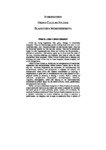Remembering the City: Memory-Images
| dc.contributor.author | Rae, I | |
| dc.contributor.editor | Momchedjikova B | |
| dc.date.accessioned | 2022-04-07T13:36:18Z | |
| dc.date.available | 2022-04-07T13:36:18Z | |
| dc.date.issued | 2013 | |
| dc.identifier.uri | http://hdl.handle.net/10026.1/19016 | |
| dc.description.abstract |
The research is located within the discipline of photographic studies. It is an investigation into the relation of the photographic work to the world depicted, and the balance achieved between the neutral document, mirroring reality, and the latent criticism of that reality. Through a photographic practice that uses methods of visual ethnography, alongside an interest in the complexity of the relationship between urban representations, memory, place, and identity, it is possible to piece together the particularities of lived experience. The current project, Memory City, documents a series of personal memories volunteered by inhabitants of Preston and an attempt to explore the relationship between personal memory and public space. It opens up a dialogue between the city’s population to encourage them to claim ownership over their public space by experiencing it as a dynamic site where private memories and a public present interact. One of the goals of the project is to explore people’s, shared and differing, senses of belonging and document the emotional histories that exist in the living memories of a city’s inhabitants; to enable a narration of the city “from below” in order to expose the dynamic, personal qualities of urban change. We live in a “memorious” world where every step and every movement we make encounters memorialised objects, spaces and relations. The streets we walk along and the roads we drive upon are filled with engravings of past practices. The grooves in the pavement where millions of feet have worn down the surface, the variety of street furniture designs memorialising different industrial and social fashions: our environments are scarred by historical memories. What kinds of memory engravings have been inscribed on those places but also what kind of engravings are being inscribed upon those places? In this essay I look at some of the memory-talk and memory-images that the people in the Memory City project used to define the place of their memories in the urban spaces of Preston’s past. Preston, one of the UK’s newest cities, has often found itself in the shadow of larger cities in the North West of the UK, namely Manchester and Liverpool. The Memory City project chose Preston for its research in order to encourage the exploration of Preston as a subject for photographic studies and to generally focus more attention on the city. | |
| dc.language.iso | en | |
| dc.publisher | Cambridge Scholars Press | |
| dc.relation.ispartof | Captured by the City; New Perspectives in Urban Culture Studies | |
| dc.subject | Urban culture | |
| dc.subject | Photography | |
| dc.title | Remembering the City: Memory-Images | |
| dc.type | chapter | |
| plymouth.publisher-url | http://www.c-s-p.org/ | |
| plymouth.publication-status | In preparation | |
| plymouth.organisational-group | /Plymouth | |
| plymouth.organisational-group | /Plymouth/Faculty of Arts, Humanities and Business | |
| plymouth.organisational-group | /Plymouth/Faculty of Arts, Humanities and Business/School of Art, Design and Architecture | |
| plymouth.organisational-group | /Plymouth/Users by role | |
| plymouth.organisational-group | /Plymouth/Users by role/Academics | |
| dc.rights.embargoperiod | Not known | |
| rioxxterms.licenseref.uri | http://www.rioxx.net/licenses/all-rights-reserved | |
| rioxxterms.type | Book chapter |


